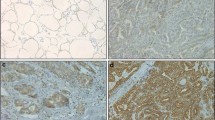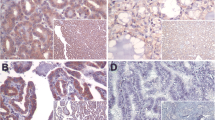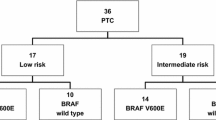Abstract
The objective of this study is to detect the expression of midkine (MK) in papillary thyroid cancer (PTC) and to evaluate whether MK expression is associated with clinicopathological features and BRAF mutation in PTC. The expression of MK in samples from 200 cases of PTC, 60 cases of adenomatoid nodule of thyroid, and 40 samples of tumor-adjacent normal thyroid tissue were assessed with immunohistochemistry. The BRAF mutation was detected by direct sequencing. The relationships between MK expression and the clinicopathological features of PTC and BRAF mutation were analyzed. The results demonstrated that MK was not expressed in tumor-adjacent normal tissue. The positive expression rates and MK scores were both higher in PTC than in adenomatoid nodule (positive expression rates: 88 vs. 8.3 %, P < 0.001; MK scores: 2.02 ± 0.93 vs. 0.08 ± 0.28, P < 0.001). The expression level of MK in PTC with extrathyroidal invasion, lymph node metastasis, or stage III/IV was significantly higher than that in PTC without such biological features (all P < 0.01). The overall prevalence of BRAF mutation was 66.5 % in PTC. The expression level of MK in PTC with BRAF mutation was significantly higher than that in PTC with wild-type BRAF (P < 0.001). We can conclude that MK is specifically expressed in PTC tissues and is associated with clinicopathological features and BRAF mutation. MK may be a helpful diagnostic and prognostic marker for PTC.


Similar content being viewed by others
References
L. Davies, H.G. Welch, Increasing incidence of thyroid cancer in the United States, 1973–2002. JAMA 295(18), 2164–2167 (2006)
E.L. Mazzaferri, S.M. Jhiang, Long-term impact of initial surgical and medical therapy on papillary and follicular thyroid cancer. Am. J. Med. 97(5), 418–428 (1994)
M. Xing, BRAF mutation in papillary thyroid cancer: pathogenic role, molecular bases, and clinical implications. Endocr. Rev. 28(7), 742–762 (2007)
J.A. Knauf, X. Ma, E.P. Smith, L. Zhang, N. Mitsutake, X.H. Liao, S. Refetoff, Y.E. Nikiforov, J.A. Fagin, Targeted expression of BRAFV600E in thyroid cells of transgenic mice results in papillary thyroid cancers that undergo dedifferentiation. Cancer Res. 65(10), 4238–4245 (2005)
N. Kurtulmus, M. Duren, U. Ince, M.C. Yakicier, O. Peker, O. Aydin, A. Ender, S. Giray, H. Azizlerli, BRAF(V600E) mutation in Turkish patients with papillary thyroid cancer: strong correlation with indicators of tumor aggressiveness. Endocrine 42(2), 404–410 (2012)
K. Kadomatsu, M. Tomomura, T. Muramatsu, cDNA cloning and sequencing of a new gene intensely expressed in early differentiation stages of embryonal carcinoma cells and in mid-gestation period of mouse embryogenesis. Biochem. Biophys. Res. Commun. 151(3), 1312–1318 (1988)
J. Tsutsui, K. Kadomatsu, S. Matsubara, A. Nakagawara, M. Hamanoue, S. Takao, H. Shimazu, Y. Ohi, T. Muramatsu, A new family of heparin-binding growth/differentiation factors: increased midkine expression in Wilms’ tumor and other human carcinomas. Cancer Res. 53(6), 1281–1285 (1993)
K. Ota, H. Fujimori, M. Ueda, H. Jono, S. Shinriki, T. Ota, T. Sueyoshi, M. Taura, A. Taguma, H. Kai, M. Shinohara, Y. Ando, Midkine expression is correlated with an adverse prognosis and is down-regulated by p53 in oral squamous cell carcinoma. Int. J. Oncol. 37(4), 797–804 (2010)
Li.L. Qin, H.L. Huang, J.L. Ping, W. Xu, J. Li, L.C. Dai, Expression of midkine and endoglin in breast carcinomas with different immunohistochemical profiles. APMIS 119(2), 103–110 (2011)
G.E. Rice, T.A. Edgell, D.J. Autelitano, Evaluation of midkine and anterior gradient 2 in a multimarker panel for the detection of ovarian cancer. J. Exp. Clin. Cancer. Res. 29, 62 (2010)
A. Nordin, W. Wang, K. Welén, J.E. Damber, Midkine is associated with neuroendocrine differentiation in castration-resistant prostate cancer. Prostate 73(6), 657–667 (2013)
S. Kishida, P. Mu, S. Miyakawa, M. Fujiwara, T. Abe, K. Sakamoto, A. Onishi, Y. Nakamura, K. Kadomatsu, Midkine promotes neuroblastoma through Notch2 signaling. Cancer Res. 73(4), 1318–1327 (2013)
D.S. Cooper, G.M. Doherty, B.R. Haugen, R.T. Kloos, S.L. Lee, S.J. Mandel, E.L. Mazzaferri, B. McIver, F. Pacini, M. Schlumberger, S.I. Sherman, D.L. Steward, R.M. Tuttle, Revised American Thyroid Association management guidelines for patients with thyroid nodules and differentiated thyroid cancer. Thyroid 19(11), 1167–1214 (2009)
F. Pacini, Changing natural history of differentiated thyroid cancer. Endocrine 42(2), 229–230 (2012)
T. Kunavisarut, Diagnostic biomarkers of differentiated thyroid cancer. Endocrine (2013). doi:10.1007/s12020-013-9974-2
A. Guerra, V. Marotta, M. Deandrea, M. Motta, P.P. Limone, A. Caleo, P. Zeppa, S. Esposito, F. Fulciniti, M. Vitale, BRAF(V600E) associates with cytoplasmatic localization of p27kip1 and higher cytokeratin 19 expression in papillary thyroid carcinoma. Endocrine 44(1), 165–171 (2012)
M. Kato, H. Maeta, S. Kato, T. Shinozawa, T. Terada, Immunohistochemical and in situ hybridization analyses of midkine expression in thyroid papillary carcinoma. Mod. Pathol. 13(10), 1060–1065 (2000)
M. Xing, BRAF mutation in thyroid cancer. Endocr. Relat. Cancer 12(2), 245–262 (2005)
E. Puxeddu, C. Durante, N. Avenia, S. Filetti, D. Russo, Clinical implications of BRAF mutation in thyroid carcinoma. Trends Endocrinol. Metab. 19(4), 138–145 (2008)
Acknowledgments
This study was financially supported by the National Science Foundation of China (Grant # 3080112), the Key Laboratory Program Foundation of Education Department of Liaoning Province (Grant # LS2010163), and the Fund for Scientific Research of The First Hospital of China Medical University (Grant # FSFH1202).
Conflict of interest
The authors declare that they have no conflict of interest.
Author information
Authors and Affiliations
Corresponding authors
Rights and permissions
About this article
Cite this article
Shao, H., Yu, X., Wang, C. et al. Midkine expression is associated with clinicopathological features and BRAF mutation in papillary thyroid cancer. Endocrine 46, 285–291 (2014). https://doi.org/10.1007/s12020-013-0068-y
Received:
Accepted:
Published:
Issue Date:
DOI: https://doi.org/10.1007/s12020-013-0068-y




